|
||
|
||
 |
||
| Accommodation Activities Korcula Island Croatia Maps Arrival Photogallery |
Korcula Island |
|
Korcula, an island in the central Dalmatian archipelago; area 279.03 sq km (length 46.8 km, width 5.3-7.8 km); population 17,038; the coast is rather indented. The highest peaks are Klupca (568 m) and Kom (510 m). The climate is mild; an average air temperature in January is 9.8 °C (in the town of Korcula) and in July 26.9 °C; the average annual rainfall is 1,100 mm; the annual insolation reaches 2,671 hours (Vela Luka). The island is largely covered with the Mediterranean flora; at some places are pine forests. Economy is based on farming, viticulture, fruit growing, fishing and fish processing, shipbuilding, processing of synthetic materials and tourism. Summer tourism has a long tradition on the island; nautical tourism has been recently developed. Major places on the coast are Korcula, Lumbarda, Vela Luka, Raciste, and in the interior Blato, Zrnovo, Smokvica, Cara and Pupnat. The regional road connects major places on the island. Ferry lines connect the island of Korcula with the mainland. The island was inhabited as early as the Neolithic (cave Vela Spilja near Vela Luka, cave Jakasova Spilja above the cove of Rasohatica, Zrnovo) and the Bronze Age. A Greek colony existed here in the 6th and the 5th centuries BC; at that time the island was called Korkyra Melaina (remains of Greek habitations in Lumbarda, in the vicinity of Blato and in Potirna). 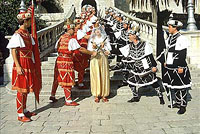 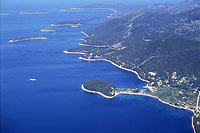 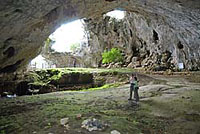 From 35 BC the island was part of the Roman Empire; traces of Roman settlements have been discovered in the vicinity of Lumbarda, Vela Luka (locality Beneficij), Blago and on Pelegrin. On the collapse of the Western Roman Empire, the island became part of the Ostrogoth state (AD 493) and then came under the Byzantine rule (AD 555). In the 9th century it was taken by the Nerentani/Narentini, and in AD 1000 by Venice. In 1180 the island came under the Hungarian-Croatian king (in 1214 the statute of the town and the island were passed). From 1221, during two centuries, the island had several rulers - rulers from Zahumlje, Venice (in 1298 the Genoese fleet defeated the Venetian fleet near Korcula), King Lodovic I (1358), Bosnian rulers (1390) and the Dubrovnik Republic (1413-1417). 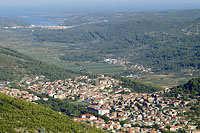 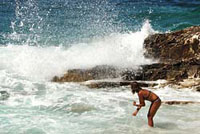 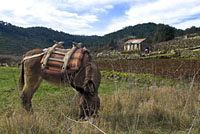 In the period 1420-1797 the island was under Venice but it retained its autonomy. Due to frequent attacks of the Turkish fleet and pirate ships (all until the beginning of the 18th c.) several important points on the island were fortified (especially the town of Korcula). - After the fall of Venice there was another period of various rulers (1797-1805 Austria, 1805-1813 France, 1813-1815 Great Britain, 1815-1918 Austria). Korcula was under the Italian occupation in the period 1918-1921, and after that was annexed to Croatia. The centre of the island, the town of Korcula, with its cultural and historical heritage, its town ramparts (similar to those of Dubrovnik) ranks among the favourite tourist destinations in southern Croatia. - As for the local economy, shipbuilding (town of Korcula, Vela Luka) and stone cutting (extraction of white marble from a quarry on the eastern coast of the island) have been important branches for centuries. |
Town of Korcula |
|
The town of Korcula, the historical centre of the island, has a very nice location in the Peljesac Channel. It is also known for its outstanding cultural and historical heritage and a long tradition in seafaring, shipbuilding and stone-masonry. It is the birthplace of the adventurer and traveller Marco Polo. Today Korcula is an important tourist centre. Tourism has a years-long tradition on the island. The first modern hotel, Korcula, was opened in 1912, in a building erected in 1871. Hotel guests have been enjoying the sunset at the hotel terrace for decades, which is a unique experience in the early summer. 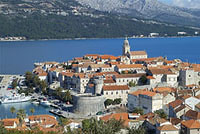 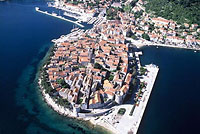 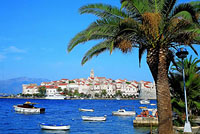 |
| find more: Korčula » |
Blato |
|
With its harmonious urban whole, Blato aroused interest of a number of travelogue writers as early as the 18th century. The centre of the town features a nice line of lime-trees, stretching for more than 1 km, providing a unique experience in June, when lime-trees are blossoming. In front of them is a group of islands with beautiful beaches. On the northern coast is the Prigradica Cove with a nice harbour. 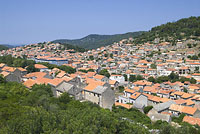 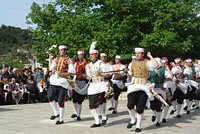 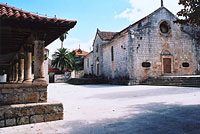 |
| find more: Blato » |
Vela Luka |
|
On the western part of Korčula Island lies the town of Vela Luka, a small town situated in a deep and large bay, surrounded with many coves, whose shores are covered with fig trees, vineyards, olive trees and pines as they mildly descend to the sea. With its 4500 residents, Vela Luka is the second largest island town among the islands in the Adriatic Sea and a safe port and anchorage for sailors. Broad panoramic views, mild Mediterranean climate, crystal-blue sea, interesting and rich cultural heritage, various locations for sport and recreation, entertaining programs, but above all its kind and friendly locals make Vela Luka an attractive tourist destination. 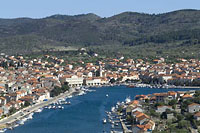 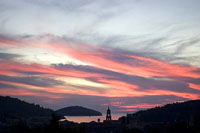 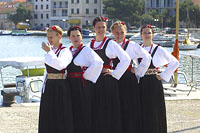 |
| find more: Vela Luka » |
| © korcula-triporte.com 2008 |